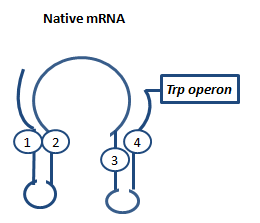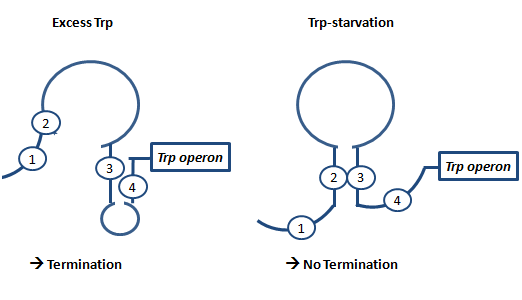Team:TU Munich/Glossary
From 2010.igem.org
(→Abbreviations) |
(→Switch (bioLOGICS)) |
||
| Line 172: | Line 172: | ||
In case of a NOT switch, the switch forms a secondary structure which does not terminate by itself, resulting in an "on" as the default state. Upon binding of a signal, a terminator forms and transcription is stopped. | In case of a NOT switch, the switch forms a secondary structure which does not terminate by itself, resulting in an "on" as the default state. Upon binding of a signal, a terminator forms and transcription is stopped. | ||
<br> | <br> | ||
| + | For further information of how to construct a switch, please check [https://2010.igem.org/Team:TU_Munich/Project#Results here] for detailed information. | ||
Individual switches can be used to built up a logical network which only consists of DNA/RNA elements for individual applications with the help of [https://2010.igem.org/Team:TU_Munich/Software/Applet this applet]. | Individual switches can be used to built up a logical network which only consists of DNA/RNA elements for individual applications with the help of [https://2010.igem.org/Team:TU_Munich/Software/Applet this applet]. | ||
Revision as of 11:56, 26 October 2010
|
||||||||||||||||||||||||||||||||||||||||||||||||||||
|
|
AbbreviationsiGEM TUM2010
For non-scientists
AntiterminationAntitermination exists in two different ways in bacterial cells: Protein dependent antitermination and protein-independent antiterminaiton. In general antitermination is regulatory mechanism where a Rho-independent terminator in front of a gene inhibits transcription except when a corresponding sequences binds and leads to an alternative folding conformation of the RNA, allowing transcription beyond the terminator. Protein-independent antitermination in nature is often used to control biosynthetic operons and adapt gene expression in response to environmental changes.[1] The principle our project relies on basic antitermination principles but is completely different from previously decribed cases. In May 2010 (in the middle of our iGEM project and experiments by the way), Kang and coworkers published a paper about antitermination by small RNA pieces which are formed during transcription initiation.[2] The principle described here is similiar to the theory we based our switching principle on and work described in this paper we later used to base some in vitro T7 measurements on. AptamerAptamers in our case are defined as artificially designed single stranded nucleotides designated to specifically bind ligands. Large combinatorial libraries of RNA or DNA molecules are used to isolate and evolve aptamers which achieve surprisingly high affinity and specifity.[3] Aptamers can be used for a broad range of applications: While in our case the malachitegreen-binding aptamer is only used for detection of RNA synthesis in response to an antitermination signal, other approaches use aptamers for regulating gene expression and - together with ribozymes - to design logical gates. By introducing the malachite-green binding aptamer to the Parts Registry we provide a nice tool to evaluate transcription both in vitro and in vivo. Malachite green binding aptamers were already for screening assays[4] and aptamers in general were lately tested in mammalian cells in vivo (F. Simmel, personal communication). AttenuationAttenuation is a very smart way of gene regulation which is known from bacterial cells using two alternatice hairpin structures. For example, E. coli only needs very little amounts of Tryptophan in its metabolism, so the amino-acyl-Synthetase for Tryptophan is only rarely synthesized. So the trp-operon contains an attenuator before the actual enzymes. If Tryptophan is absent, the rare tRNA loaded with Tryptophan will not be available at once, so the Ribosome is stalled. Sterics do not allow the formation of a certain stemloop with the ribosome attached. If there is Tryptophan available and many tRNATrp float through the cell, the ribosome can just continue, a stem loop is formed and the ribosome falls off: The transcription of the following trp-operon is terminated.
His-TermThe nickname His-Term we used mostly in the same meaning as His-Switch. His refers to the terminator hairpin in the his-operon of Salmonella enterica. The His-terminator was one of the most thoroughly evaluated terminators we tested in our experimental work. The His-terminator was chosen because of its role in the metabolic regulation where its antitermination also leads to a read-through of genes needed in biosynthetic pathways. iGEMi'm Gonna End up in Massachusetts... [10] KinefoldThe Kinefold web server provides the possibility to predict folding kinetics of RNA and DNA structures. Kinefold is capable of handling knots and pseudoknots. The most important feature in our case is the possibility to monitor the time-frame of our RNA/RNA-interaction. The kinefold web server can be reached [http://kinefold.curie.fr here]. Linker (modeling)Since Kinefold, the program of choice we used for modeling, can only calculate folding kinetics of individual RNA structures and not the interaction between two structures, which would our case, since it relies on a switch and a corresponding signal, a linker sequence is used to combine both sequences in one. The linker, shown as a row of (X) can be set to a specific length and does not interact. It mostly serves as a mere placeholder in this model, effects of the linker nevertheless influence the folding time. Since in reality the linker might be thought of as of infinite length, the results shown for the His-terminator in the modeling section considering varying linker lengths actually supports our model: long linkers level the influence of the signal length in time while the minimal free-energy is hardly influenced by the linker length. Logical circuitA logical circuits consists of switches, which can be connected with each other leading to a circuit which reacts to specific signals. The most common logical circuits are AND, OR and NOT. While AND/OR can be built up using switches, which have an "off" default state and are changed to "on" upon binding of a signal, must always consist of at least to switches, a NOT circuit can consist only of one switch with an "off" default state which is changed to "on" upon binding of a signal. Recognition Site (bioLOGICS)The recognition site is the part of a switch, which provides specifity towards the corresponding signal. While the switching element, fulfills the main duty of the switch, to change between an "on" and an "off" state and consists by definition of a terminator in the case of switches which built up AND/OR circuits and may be the same for a whole network, the recognition site provides the needed specifity for a switch to be only recognized by the corresponding signal and can consist of any sequence. RiboswitchWhile artificial aptamers are designed to specifally bind their ligands, riboswitches are developed by nature for gene regulation in prokaryotes, with some also found in eukaryotes. Riboswitches are part of mRNAs they control, located in the non-coding parts. They bind to specific metabolites and control gene expression by changing the three-dimensional RNA structures using effects like transcription elongation or translation initiation. Riboswitches typically consist of two parts, the aptamer domain and the expression platform. While the aptamer domain recognizes the metabolite specifically, the expression platforms allows transduction from metabolite binding to gene control by influencing the effciency of translation initiation, transcriptional elongation or stabilizing the mRNA in general. Signal (bioLOGICS)Signals are what make a switch a switch. Without the corresponding signal, the switches of our concept are terminators. The signal leading to antitermination and setting the default "off" state in the case of a AND/OR switch to an "on". Each signal consists of a triggering unit and a specifity site. While the triggering unit provides the antitermination, the specifity site can be varied to bind to the recognition site of the switch. Specifity Site (bioLOGICS)The specifity site is the part of a signal, that recognizes and provides the binding to a switch. Together with the trigger unit which leads to antitermination, the signal can change the default state "off" of the switches which built up an AND/OR circuit to an "on" and the default state "off" in case of an NOT circuit to an "on". The specifity of the signal binds to the recognition site of a switch. Switch (bioLOGICS)A switch in our case consists of two major units, the recognition site and the switching element. While the recognition site provides the needed specifity to bind only the corresponding signal and may contain of any random sequence (as long as it fits the signal sequence), the switching element may be the same for the whole network and is by definition a terminator. In case of "on"/"off" switches, the principle is quite simple: Without the corresponding signal, the switch forms a stem loop, the RNA Polymerase falls off, transcription is terminated. By binding of a signal, antitermination occurs, the stem loop does not form, the RNA Polymerase continues transcription and the following logic gate or the desired output may be formed. Target Site (bioLOGICS)The part of a switch which forms a stem loop in the case of switches with an "off" default state used for construction of AND/OR gates or an transcriptable sequence leading to the state "on" in case of a "NOT" gate. The target site is the basic component of our switching concept, to control the structure of the target site and its consequence for the RNA Polymerase by a signal is the major characteristic of a biolOGIC switch. In principle, every terminator can be utilized as a switch by addition of a recognition site. The trigger site of a signal binds to the target site of the switch to change between "on" and "off". TerminatorIn nature, two termination principles are common in prokaryotes: Rho-dependent termination, where transcription is stopped in response of a protein factor binding to a specific sequence and Rho-independent termination, where a hairpin is formed which leads for the RNA polymerase to stop after the hairpin. Switches constructed after our concept are based on Rho-independent terminators. In principle, the target site equals a terminator. Toggle SwitchWith the term switch, toggel switches are meant if not mentioned elsewhere. A toggle switch can change between two definite states, mostly "on" and "off". While a biased switch stays in the default state until an input is received and stays in the alternative state only if the input is permanently present, a toggle switch can change its state upon a momentary input. So not permanent triggering is needed but one event is enough to lead to a change in the state. TransistorTransmittor RNATrigger Unit (bioLOGICS)The trigger unit is the part of the signal which allows interaction with the switch leading to antitermination in case of a switch which is part of a AND/OR logical gate and formation of a terminator in case of a NOT-switch. This is done by binding to the switching unit of the corresponding switch. Trp-TermThe nickname Trp-Term we used mostly in the same meaning as Trp-Switch. Trp refers to the terminator hairpin in the trp-operon of E. coli. The Trp-terminator was one of the most thoroughly evaluated terminators we tested in our experimental work. The Trp-terminator was chosen because of its role in the metabolic regulation where its antitermination also leads to a read-through of genes needed in biosynthetic pathways. References [1] Yanofsky, C., Transcription attenuation. Journal of Biological Chemistry, 1988. 263(2): p. 609. [2] Lee, S., H.M. Nguyen, and C. Kang, Tiny abortive initiation transcripts exert antitermination activity on an RNA hairpin-dependent intrinsic terminator. Nucleic Acids Research. [3] Weigand, J.E. and B. Suess, Aptamers and riboswitches: perspectives in biotechnology. Applied microbiology and biotechnology, 2009. 85(2): p. 229-236. [4] Rowe, W., M. Platt, and P.J.R. Day, Advances and perspectives in aptamer arrays. Integrative Biology, 2009. 1(1): p. 53-58. [5] Smolke and so on.... [6] http://en.wikipedia.org/wiki/Logic_gate#Symbols [6] http://en.wikipedia.org/wiki/Logic_gate#Symbols [6] http://en.wikipedia.org/wiki/Logic_gate#Symbols [6] Jan Schüürmann, personal communication |
|||||||||||||||||||||||||||||||||||||||||||||||||||
 "
"












